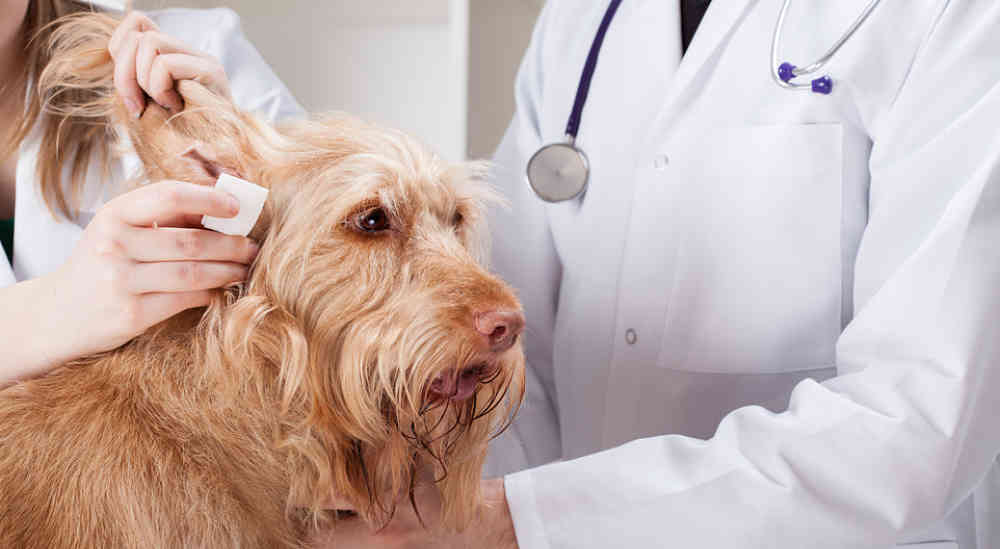Dog ear infections are one of the most common canine health problems. This is because a dog’s ears are delicate instruments. They’re prone to infections, parasite infestation and damage. And it’s a fact that most dogs will suffer from an ear infection at some point in their life.
And dog ear problems have a nasty habit of getting worse fast too. Without treatment, minor dog ear infections can soon escalate into a middle ear infection. And this will need surgery to fix, so it’s something you want to avoid.
For this reason, it’s important you keep a close eye on the health of your dog ears. And it’s also important to observe your dog’s behavior for any signs of ear problems.

Dog ear infection symptoms
Some of the tell-tale signs and symptoms of dog ear infections include:
- Your dog keeps scratching their ears.
- Your dog keeps shaking or tilting their head.
- There’s a brown or yellow discharge coming out of your dog’s ears.
- There’s a strong smell coming from your dog’s ears.
- Your dog keeps wiping their ears on the floor or couch.
- Swelling and/or redness in and around the ears.
- There’s crusty or scabby skin near the ears.
- There’s hair loss by your dog’s ears.
- Loss of hearing.
- Your dog keeps walking round in circles.
- Your dog is struggling with their balance.
- Your dog’s behavior becomes more aggressive. This can be a sign that they’re in pain.
If you notice any of these symptoms in your dog, you should get their ears checked by your vet.
What causes dog ear infections?
The most common cause of dog ear infections is a bacterial or yeast infection. Another common cause of ear infections in puppies is ear mites.
Other causes include hair growth in the ear canals, water in the ears and ear wax.
Allergies and hyperthyroidism can also cause ear infections. And so too can any foreign body that gets into the ear canal.
Which dogs are most affected?
Dogs with big, floppy ears such as cocker spaniels are at greater risk of ear infections. So too are dogs that suffer from allergies.
And dogs such as Schnauzers that are more likely to grow hair in the ear canals are also at more risk.
Ear infection treatment
There are many dog ear infection treatments you can buy yourself. You should consult with your vet before trying to treat your dog’s ear infection, though.
If your vet thinks your dog has an ear infection, they’ll examine your dog’s ears with a magnifying ear cone.
They may also take samples from your dog’s ears. They’ll then use a microscope to check them for yeast, bacteria and parasites.
Your vet may also do blood tests and allergy tests to try and work out the root cause of your dog’s ear infection.
Dog ear infection treatment most often starts with a professional cleaning. You then continue this at home with your own regular cleaning as instructed by your vet. And you’ll also give your dog any medication your vet has prescribed.
For more severe infections, your dog may need ear flushing or even surgery.
How to prevent dog ear infections
As mentioned earlier, dog ear infections are common. That doesn’t mean there aren’t things you can do to try and prevent them though. Here are a few steps you can take:
- Make sure you dry your dog’s ears as well as you can after bathing them. Also do the same after they’ve been swimming.
- If your dog suffers from allergies they may keep getting ear infections. If so, try adopting a regular ear cleaning routine. You can get ear cleaning and drying solutions. Your vet should be able to give you more advice.
- If your dog tends to get hair growth in their ear canals, use a pair of tweezers to pull it out if your dog will let you. If you send your dog to a professional groomer, you can ask that they do this for you.
- Make checking your dog’s ears part of your regular routine. Look for any of the symptom of infection described earlier. For example, swelling and redness, a strange smell, a yellow or brown discharge, and so on.
- You can also ask your vet to show you the best way to clean and maintain your dog’s ears.
Following these steps should help to reduce the chances of your dog getting an ear infection. You should always take care when handling your dog’s ears as they’re delicate.
Summary
Dog ear infections are common and your dog is likely to get an infection at some point. Breeds with floppy ears and dogs with allergies are most likely to suffer them.
If your dog shows any of the symptoms described earlier, you should take them to your vet. Your vet will be able to determine if they have an infection and, if so, the best course of treatment.
Follow the tips above to help reduce the chances of your dog getting an infection.
